-
 Bitcoin
Bitcoin $105,213.9543
-1.43% -
 Ethereum
Ethereum $2,534.1529
-5.66% -
 Tether USDt
Tether USDt $1.0004
0.02% -
 XRP
XRP $2.1293
-3.62% -
 BNB
BNB $651.6070
-1.04% -
 Solana
Solana $145.6637
-5.96% -
 USDC
USDC $0.9996
-0.01% -
 Dogecoin
Dogecoin $0.1768
-4.52% -
 TRON
TRON $0.2701
-0.48% -
 Cardano
Cardano $0.6330
-5.47% -
 Hyperliquid
Hyperliquid $41.0199
-0.92% -
 Sui
Sui $3.0216
-7.45% -
 Bitcoin Cash
Bitcoin Cash $435.1142
1.00% -
 Chainlink
Chainlink $13.1295
-7.22% -
 UNUS SED LEO
UNUS SED LEO $9.0033
1.58% -
 Stellar
Stellar $0.2582
-4.32% -
 Avalanche
Avalanche $19.0562
-7.26% -
 Toncoin
Toncoin $2.9869
-4.96% -
 Shiba Inu
Shiba Inu $0.0...01192
-3.81% -
 Hedera
Hedera $0.1561
-5.81% -
 Litecoin
Litecoin $84.9066
-3.04% -
 Polkadot
Polkadot $3.7754
-5.29% -
 Ethena USDe
Ethena USDe $1.0002
-0.02% -
 Monero
Monero $308.5756
-4.32% -
 Dai
Dai $0.9997
-0.01% -
 Bitget Token
Bitget Token $4.5027
-2.45% -
 Uniswap
Uniswap $7.3970
-4.96% -
 Pepe
Pepe $0.0...01090
-7.41% -
 Aave
Aave $279.5603
-5.99% -
 Pi
Pi $0.5658
-8.02%
How to set the trend indicator CCI? What is the short-term breakthrough threshold?
The CCI, a momentum-based indicator, helps identify trend reversals and overbought/oversold conditions in crypto trading, enhancing short-term strategies when set up correctly.
Jun 09, 2025 at 07:56 am
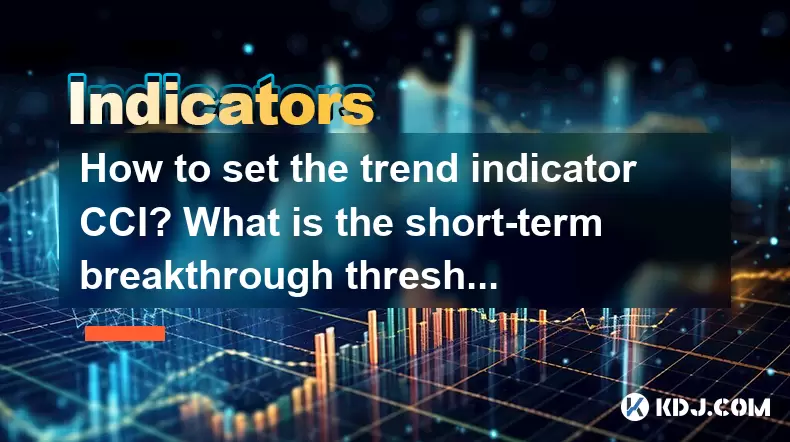
The Commodity Channel Index (CCI) is a versatile indicator used in the cryptocurrency market to identify potential trend reversals and overbought or oversold conditions. Setting up the CCI correctly and understanding its short-term breakthrough threshold can significantly enhance your trading strategy. In this article, we will delve into the specifics of setting up the CCI and exploring the short-term breakthrough threshold for effective trading in the cryptocurrency space.
Understanding the CCI Indicator
The Commodity Channel Index (CCI) is a momentum-based technical indicator that measures the difference between an asset's price change and its average price change. Developed by Donald Lambert, the CCI is typically used to identify cyclical turns in commodities, but it is equally applicable to cryptocurrencies. The CCI oscillates above and below a zero line, with readings above +100 indicating overbought conditions and readings below -100 indicating oversold conditions.
Setting Up the CCI Indicator
To set up the CCI indicator on your trading platform, follow these steps:
- Open your trading platform: Ensure you are using a platform that supports technical analysis tools, such as TradingView, MetaTrader, or Binance.
- Navigate to the indicators section: Most platforms have a dedicated section for indicators. Look for the 'Indicators' or 'Studies' tab.
- Search for CCI: Type 'CCI' in the search bar to locate the Commodity Channel Index.
- Add the CCI to your chart: Click on the CCI indicator to add it to your chart. You will typically see a new window below your price chart with the CCI line.
- Adjust the period: The default period for the CCI is 20. You can adjust this period based on your trading style. Shorter periods (e.g., 10) are more sensitive to price changes, while longer periods (e.g., 30) provide smoother signals.
- Customize the overbought/oversold levels: The standard levels are +100 and -100, but you can adjust these if needed. Some traders use +200 and -200 for more extreme conditions.
Interpreting the CCI Indicator
Understanding how to interpret the CCI is crucial for making informed trading decisions. Here are some key points to consider:
- Overbought and Oversold Conditions: When the CCI rises above +100, it indicates that the asset is overbought, suggesting a potential price correction. Conversely, when the CCI falls below -100, it signals an oversold condition, indicating a possible price rebound.
- Trend Reversals: The CCI can also help identify potential trend reversals. A move from above +100 to below +100, or from below -100 to above -100, can signal a shift in momentum.
- Divergence: Look for divergences between the CCI and price action. For example, if the price makes a new high but the CCI fails to reach a new high, it could indicate weakening momentum and a potential reversal.
Short-Term Breakthrough Threshold
The short-term breakthrough threshold for the CCI is a critical concept for traders looking to capitalize on short-term price movements. The threshold typically refers to the levels at which the CCI breaks through +100 or -100, signaling potential entry or exit points.
- Breakthrough Above +100: When the CCI breaks above +100, it suggests that the asset is entering an overbought state. Traders might consider this a signal to sell or take profits, especially if other indicators confirm the overbought condition.
- Breakthrough Below -100: Conversely, when the CCI breaks below -100, it indicates an oversold condition. This could be an opportunity to buy, particularly if other indicators support the oversold signal.
Using the CCI for Short-Term Trading
To effectively use the CCI for short-term trading in the cryptocurrency market, consider the following strategies:
- Momentum Trading: Use the CCI to identify short-term momentum shifts. When the CCI breaks above +100, consider entering a long position if the overall trend is bullish. Conversely, if the CCI breaks below -100, consider entering a short position if the trend is bearish.
- Confirmation with Other Indicators: Always use the CCI in conjunction with other indicators such as moving averages, RSI, or MACD to confirm signals. For example, if the CCI breaks above +100 and the RSI is also in overbought territory, the signal is stronger.
- Timeframe Consideration: The effectiveness of the CCI can vary depending on the timeframe you are trading. For short-term trading, use shorter timeframes (e.g., 15-minute or 1-hour charts) to capture quick price movements.
Practical Example of CCI in Action
Let's walk through a practical example of using the CCI to make a short-term trading decision in the cryptocurrency market:
- Scenario: You are monitoring Bitcoin on a 1-hour chart.
- Observation: The CCI breaks above +100, indicating an overbought condition.
- Confirmation: You check the RSI, which is also above 70, confirming the overbought signal.
- Action: You decide to sell your Bitcoin position or enter a short position, expecting a price correction.
- Result: The price of Bitcoin subsequently drops, validating your decision based on the CCI and RSI signals.
Frequently Asked Questions
Q1: Can the CCI be used effectively on all cryptocurrencies?
Yes, the CCI can be used on all cryptocurrencies, but its effectiveness may vary depending on the liquidity and volatility of the specific cryptocurrency. Highly liquid assets like Bitcoin and Ethereum tend to provide more reliable CCI signals compared to less liquid altcoins.
Q2: How often should I adjust the CCI period?
The CCI period should be adjusted based on your trading strategy and the specific market conditions. If you find that the default 20-period setting is too sensitive or not sensitive enough for your trading style, consider experimenting with different periods until you find the optimal setting for your needs.
Q3: Is the CCI suitable for long-term trading?
While the CCI is primarily used for short-term trading, it can also be applied to longer timeframes. For long-term trading, use longer periods (e.g., 50 or 100) to filter out short-term noise and focus on more significant trend reversals.
Q4: Can the CCI be used in combination with other technical analysis tools?
Absolutely, the CCI is often used in conjunction with other technical indicators to confirm signals. Combining the CCI with tools like moving averages, RSI, and MACD can provide a more comprehensive view of market conditions and enhance your trading decisions.
Disclaimer:info@kdj.com
The information provided is not trading advice. kdj.com does not assume any responsibility for any investments made based on the information provided in this article. Cryptocurrencies are highly volatile and it is highly recommended that you invest with caution after thorough research!
If you believe that the content used on this website infringes your copyright, please contact us immediately (info@kdj.com) and we will delete it promptly.
- XRP Price Shows Signs of a Bullish Recovery, With Analysts Watching Levels for an Upside Breakout
- 2025-06-14 04:50:12
- XRP Price Shows Signs of a Bullish Recovery, as Analysts Watch Levels for an Upside Breakout
- 2025-06-14 04:50:12
- Leading Cryptocurrencies Dipped Despite Lower-Than-Expected Inflation and the New Trade Deal Announcement with China.
- 2025-06-14 04:45:12
- XRP Price Prediction: Can the Token Reach $73 This Cycle?
- 2025-06-14 04:40:12
- Bitcoin Hashrate Reaches All-Time High, Exceeding 943 EH/s
- 2025-06-14 04:40:12
- Bitcoin Hits Local ATH but Analysts Warn: Time to Sell and Watch Key Support
- 2025-06-14 04:35:13
Related knowledge

Is it an opportunity for the long positive line with large volume to break through the platform and then shrink back?
Jun 14,2025 at 04:42am
Understanding the Long Positive Line with Large VolumeIn technical analysis, a long positive line refers to a candlestick pattern where the closing price is significantly higher than the opening price, often indicating strong buying pressure. When this occurs alongside large volume, it suggests that market participants are actively involved in pushing t...
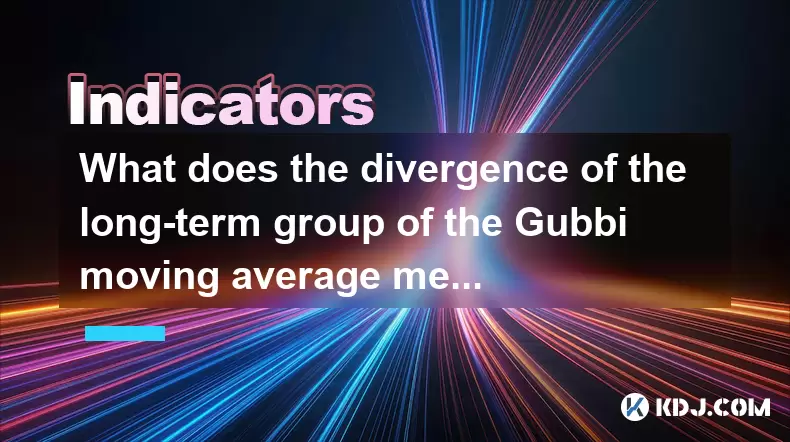
What does the divergence of the long-term group of the Gubbi moving average mean? How long can the trend last?
Jun 14,2025 at 02:56am
Understanding the Gubbi Moving AverageThe Gubbi moving average is a technical indicator used by traders in cryptocurrency markets to identify trends and potential reversals. Unlike traditional moving averages, the Gubbi variant incorporates unique calculations that emphasize price momentum and volatility adjustments. This makes it particularly useful fo...
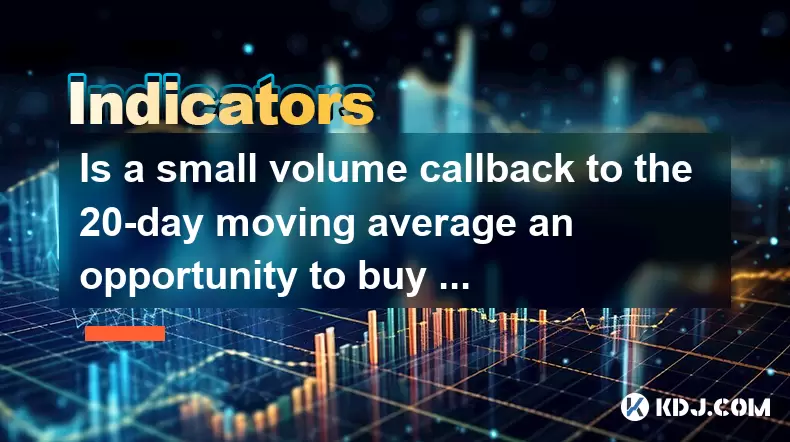
Is a small volume callback to the 20-day moving average an opportunity to buy low? What is the key to look at?
Jun 14,2025 at 02:28am
Understanding the 20-Day Moving Average in Cryptocurrency TradingIn cryptocurrency trading, the 20-day moving average (20DMA) is a commonly used technical indicator that helps traders assess the short-term trend of an asset. It calculates the average price of a cryptocurrency over the last 20 days and smooths out price volatility. When a coin experience...
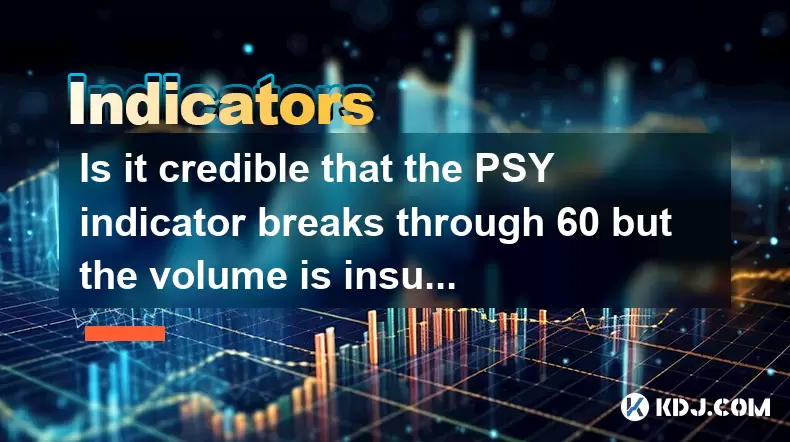
Is it credible that the PSY indicator breaks through 60 but the volume is insufficient?
Jun 14,2025 at 12:14am
Understanding the PSY Indicator in Cryptocurrency TradingThe Psychological Line (PSY) indicator is a momentum oscillator used primarily to measure the sentiment of traders and investors in financial markets, including the cryptocurrency space. It calculates the ratio of days where prices closed higher versus lower over a specified period, typically 12 o...
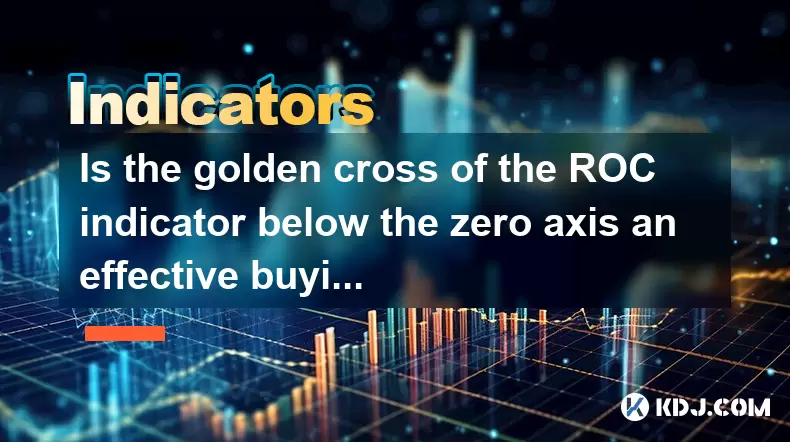
Is the golden cross of the ROC indicator below the zero axis an effective buying point?
Jun 14,2025 at 01:29am
Understanding the ROC Indicator and Its SignificanceThe Rate of Change (ROC) indicator is a momentum oscillator used in technical analysis to measure the percentage change in price between the current closing price and the closing price from a set number of periods ago. This tool helps traders assess the speed at which prices are changing, offering insi...
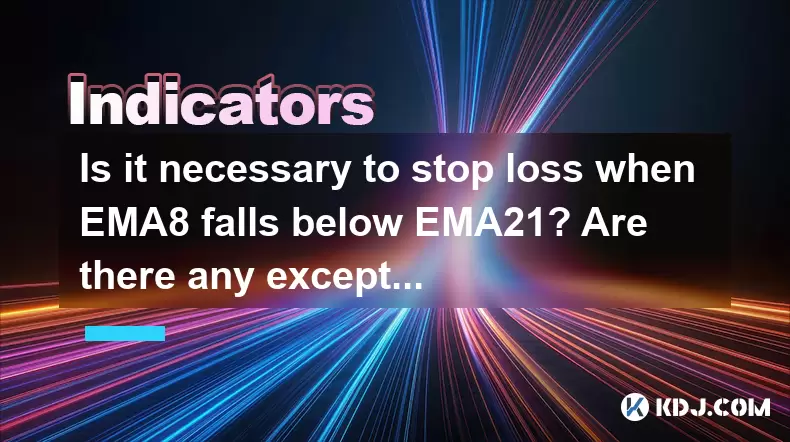
Is it necessary to stop loss when EMA8 falls below EMA21? Are there any exceptions?
Jun 14,2025 at 02:42am
Understanding EMA8 and EMA21 in Cryptocurrency TradingIn cryptocurrency trading, Exponential Moving Averages (EMAs) are widely used technical indicators to identify trends and potential reversal points. The EMA8 refers to the 8-period exponential moving average, while EMA21 is the 21-period EMA. These tools help traders make informed decisions by smooth...

Is it an opportunity for the long positive line with large volume to break through the platform and then shrink back?
Jun 14,2025 at 04:42am
Understanding the Long Positive Line with Large VolumeIn technical analysis, a long positive line refers to a candlestick pattern where the closing price is significantly higher than the opening price, often indicating strong buying pressure. When this occurs alongside large volume, it suggests that market participants are actively involved in pushing t...

What does the divergence of the long-term group of the Gubbi moving average mean? How long can the trend last?
Jun 14,2025 at 02:56am
Understanding the Gubbi Moving AverageThe Gubbi moving average is a technical indicator used by traders in cryptocurrency markets to identify trends and potential reversals. Unlike traditional moving averages, the Gubbi variant incorporates unique calculations that emphasize price momentum and volatility adjustments. This makes it particularly useful fo...

Is a small volume callback to the 20-day moving average an opportunity to buy low? What is the key to look at?
Jun 14,2025 at 02:28am
Understanding the 20-Day Moving Average in Cryptocurrency TradingIn cryptocurrency trading, the 20-day moving average (20DMA) is a commonly used technical indicator that helps traders assess the short-term trend of an asset. It calculates the average price of a cryptocurrency over the last 20 days and smooths out price volatility. When a coin experience...

Is it credible that the PSY indicator breaks through 60 but the volume is insufficient?
Jun 14,2025 at 12:14am
Understanding the PSY Indicator in Cryptocurrency TradingThe Psychological Line (PSY) indicator is a momentum oscillator used primarily to measure the sentiment of traders and investors in financial markets, including the cryptocurrency space. It calculates the ratio of days where prices closed higher versus lower over a specified period, typically 12 o...

Is the golden cross of the ROC indicator below the zero axis an effective buying point?
Jun 14,2025 at 01:29am
Understanding the ROC Indicator and Its SignificanceThe Rate of Change (ROC) indicator is a momentum oscillator used in technical analysis to measure the percentage change in price between the current closing price and the closing price from a set number of periods ago. This tool helps traders assess the speed at which prices are changing, offering insi...

Is it necessary to stop loss when EMA8 falls below EMA21? Are there any exceptions?
Jun 14,2025 at 02:42am
Understanding EMA8 and EMA21 in Cryptocurrency TradingIn cryptocurrency trading, Exponential Moving Averages (EMAs) are widely used technical indicators to identify trends and potential reversal points. The EMA8 refers to the 8-period exponential moving average, while EMA21 is the 21-period EMA. These tools help traders make informed decisions by smooth...
See all articles

























































































